High Energy Parametric Laser Source and Frequency-Comb-Based Wavelength Reference for CO2 and Water Vapor DIAL in the 2 µm Region: Design and Pre-Development Experimentations
Abstract
1. Introduction
- -
- Demonstrate high-energy operation of a 2 µm laser transmitter based on the NesCOPO-MOPA approach in a relevant environment. For this, our goal is set in line with the requirements for CO2 IPDA measurement from space previously mentioned while keeping a fairly compact footprint for airborne operation. For this purpose, the design is fully oriented around quasi-phase-matched nonlinear materials, including state-of-the-art periodically-poled nonlinear materials, such as high aperture periodically poled Potassium Titanyle Phosphate crystals (PPKTP).
- -
- Demonstrate high power operation and high-frequency stability within distinct spectral windows located at 1.98 µm for water vapor isotopic ratio, and at 2.05 µm for CO2. For this purpose, a broadband frequency reference unit (FRU) based on frequency comb generation and beat note analysis with the laser transmitter laser output is exposed. Once again, the design is oriented by a frequency referencing capability goal in line with CO2 measurement from space.
2. Proposed Instrument Concept
2.1. Instrument Requirements
2.2. Conceptual Instrument Design
3. Laser transmitter Optical Design and Preliminary Validation Results
3.1. Housing 1: Pump Laser and Nested-Cavity OPO (NesCOPO)
3.1.1. NesCOPO Architecture
3.1.2. Performance Simulations, Experimental Validation, and Design Optimization
3.2. Housing 2: Optical Parametric Amplification (OPA) Stage
3.2.1. Nonlinear Crystal Design and Characterization
3.2.2. Preliminary OPA Testing and Performance Simulations
4. Frequency Measurement and Referencing
4.1. NesCOPO Frequency Locking by Wavemeter
4.2. Frequency Reference Unit Based on Optical Frequency Comb
5. Conclusions
Author Contributions
Funding
Institutional Review Board Statement
Informed Consent Statement
Data Availability Statement
Conflicts of Interest
References
- Ehret, G.; Bousquet, P.; Pierangelo, C.; Alpers, M.; Millet, B.; Abshire, J.B.; Bovensmann, H.; Burrows, J.P.; Chevallier, F.; Ciais, P.; et al. MERLIN: A French-German Space Lidar Mission Dedicated to Atmospheric Methane. Remote Sens. 2017, 9, 1052. [Google Scholar] [CrossRef]
- ASCENDS Workshop Steering Committee. Active Sensing of CO2 Emissions over Nights, Days, and Seasons (ASCENDS) Mission. NASA Science Definition and Planning Workshop Report; University of Michigan: Ann Arbor, MI, USA, 2008. [Google Scholar]
- Ciais, P.; Crisp, D.; Van der Gon, H.D.; Engelen, R.; Janssens-Maenhout, G.; Heiman, M.; Rayner, P.; Scholze, M. Towards a European Operational Observing System to Monitor Fossil CO2 Emissions, Final Report from the Expert Group; European Commission: Brussels, Belgium, 2015. [Google Scholar]
- ESA. Report for Assessment, SP-1313/1. A-SCOPE—Advanced Space Carbon and Climate Observation of Planet Earth; ESA-ESTEC: Noordwijk, The Netherlands, 2008. [Google Scholar]
- Ehret, G.; Kiemle, C.; Wirth, M.; Amediek, A.; Fix, A.; Houweling, S. Space-borne remote sensing of CO2, CH4, and N2O by integrated path differential absorption lidar: A sensitivity analysis. Appl. Phys. B 2008, 90, 593–608. [Google Scholar] [CrossRef]
- Singh, U.N.; Refaat, T.F.; Ismail, S.; Davis, K.J.; Kawa, S.R.; Menzies, R.T.; Petros, M. Feasibility study of a space-based high pulse energy 2 μm CO2 IPDA lidar. Appl. Opt. 2017, 56, 6531–6547. [Google Scholar] [CrossRef] [PubMed]
- Fix, A.; Matthey, R.; Amediek, A.; Ehret, G.; Gruet, F.; Kiemle, C.; Klein, V.; Mileti, G.; Do Carmo, J.P.; Quatrevalet, M. Investigations on frequency and energy references for a space-borne integrated path differential absorption lidar. In Proceedings of the International Conference on Space Optics—ICSO 2014, Tenerife, Canary Islands, Spain, 6–10 October 2014; SPIE: Bellingham, WA, USA, 2017; Volume 10563, p. 105630A. [Google Scholar]
- Caron, J.; Durand, Y. Operating wavelengths optimization for a spaceborne lidar measuring atmospheric CO2. Appl. Opt. 2009, 48, 5413–5422. [Google Scholar] [CrossRef]
- Ambrico, P.F.; Amodeo, A.; Di Girolamo, P.; Spinelli, N. Sensitivity analysis of differential absorption lidar measurements in the mid-infrared region. Appl. Opt. 2000, 39, 6847–6865. [Google Scholar] [CrossRef] [PubMed]
- Menzies, R.T.; Tratt, D.M. Differential Laser absorption spectrometry for global profiling of tropospheric carbon dioxide: Selection of optimum sounding frequencies for high-precision measurements. Appl. Opt. 2003, 42, 6569–6577. [Google Scholar] [CrossRef]
- Bruneau, D.; Quaglia, P.; Flamant, C.; Meissonnier, M.; Pelon, J. Airborne lidar LEANDRE II for water vapour profiling in the troposphere. Appl. Opt. 2001, 40, 3450–3475. [Google Scholar] [CrossRef]
- Wirth, M.; Fix, A.; Mahnke, P.; Schwarzer, H.; Schrandt, F.; Ehret, G. The airborne multi-wavelength water vapor differential absorption lidar WALES: System design and performance. Appl. Phys. B 2009, 96, 201. [Google Scholar] [CrossRef]
- Kiemle, C.; Ehret, G.; Amediek, A.; Fix, A.; Quatrevalet, M.; Wirth, M. Potential of Spaceborne Lidar Measurements of Carbon Dioxide and Methane Emissions from Strong Point Sources. Remote Sens. 2017, 9, 1137. [Google Scholar] [CrossRef]
- Singh, U.N.; Petros, M.; Refaat, T.F.; Yu, J.; Ismail, S. Column carbon dioxide and water vapor measurements by an airborne triple-pulse integrated path differential absorption lidar—Novel lidar technologies and techniques with path to space. In Proceedings of the International Conference on Space Optics—ICSO 2016, Biarritz, France, 18–21 October 2016; SPIE: Bellingham, WA, USA, 2017; Volume 10562, p. 105621R. [Google Scholar]
- Wagner, G.; Plusquellic, D. Ground-based, integrated path differential absorption LIDAR measurement of CO2, CH4, and H2O near 1.6 μm. Appl. Opt. 2016, 55, 6292. [Google Scholar] [CrossRef]
- Refaat, T.F.; Ismail, S.; Koch, G.J.; Rubio, M.; Mack, T.L.; Notari, A.; Collins, J.E.; Lewis, J.; De Young, R.; Choi, Y.; et al. Backscatter 2 µm Lidar Validation for Atmospheric CO2 Differential Absorption Lidar Applications. IEEE Trans. Geosci. Remote Sens. 2011, 49, 572–580. [Google Scholar] [CrossRef]
- Refaat, T.; Singh, U.; Yu, J.; Petros, M.; Remus, R.; Ismail, S. Double-pulse 2-μm integrated path differential absorption lidar airborne validation for atmospheric carbon dioxide measurement. Appl. Opt. 2016, 55, 4232–4246. [Google Scholar] [CrossRef] [PubMed]
- Spiers, G.D.; Menzies, R.T.; Jacob, J.; Christensen, L.E.; Phillips, M.W.; Choi, Y.; Browell, E.V. Atmospheric CO2 measurements with a 2 μm airborne laser absorption spectrometer employing coherent detection. Appl. Opt. 2011, 50, 2098. [Google Scholar] [CrossRef]
- Abshire, J.B.; Riris, H.; Weaver, C.J.; Mao, J.; Allan, G.R.; Hasselbrack, W.E.; Browell, E.V. Airborne measurements of CO2 column absorption and range using a pulsed direct-detection integrated path differential absorption lidar. Appl. Opt. 2013, 52, 4446. [Google Scholar] [CrossRef] [PubMed]
- Numata, K.; Riris, H.; Li, S.; Wu, S.; Kawa, S.R.; Krainak, M.; Abshire, J.B. Ground demonstration of trace gas lidar based on optical parametric amplifier. J. Appl. Remote Sens. 2012, 6, 63561. [Google Scholar] [CrossRef]
- Riris, H.; Numata, K.; Wu, S.; Gonzalez, B.; Rodriguez, M.; Scott, S.; Kawa, S.; Mao, J. Methane optical density measurements with an integrated path differential absorption lidar from an airborne platform. J. Appl. Remote Sens. 2017, 11, 034001. [Google Scholar] [CrossRef] [PubMed]
- Amediek, A.; Fix, A.; Wirth, M.; Ehret, G. Development of an OPO system at 1.57 μm for integrated path DIAL measurement of atmospheric carbon dioxide. Appl. Phys. B 2008, 92, 295–302. [Google Scholar] [CrossRef]
- Uchiumi, M.; Vasa, N.J.; Fujiwara, M.; Yokoyama, S.; Maeda, M.; Uchino, O. Development of DIAL for CO2 and CH4 in the atmosphere. In Lidar Remote Sensing for Industry and Environment Monitoring III; Singh, U.N., Itabe, T., Liu, Z., Eds.; International Society for Optics and Photonics: Bellingham, WA, USA, 2003; Volume 4893, pp. 141–149. [Google Scholar]
- Ishii, S.; Mizutani, K.; Baron, P.; Iwai, H.; Oda, R.; Itabe, T.; Fukuoka, H.; Ishikawa, T.; Koyama, M.; Tanaka, T.; et al. Partial CO2 Column-Averaged Dry-Air Mixing Ratio from Measurements by Coherent 2-μm Differential Absorption and Wind Lidar with Laser Frequency Offset Locking. J. Atmos. Ocean. Technol. 2012, 29, 1169–1181. [Google Scholar] [CrossRef]
- Kameyama, S.; Imaki, M.; Hirano, Y.; Ueno, S.; Kawakami, S.; Sakaizawa, D.; Nakajima, M. Performance improvement and analysis of a 1.6 μm continuous-wave modulation laser absorption spectrometer system for CO2 sensing. Appl. Opt. 2011, 50, 1560. [Google Scholar] [CrossRef]
- Sakaizawa, D. Ground-based demonstration of a CO2 remote sensor using a 1.57 μm differential laser absorption spectrometer with direct detection. J. Appl. Remote Sens. 2010, 4, 43548. [Google Scholar] [CrossRef]
- Gibert, F.; Pellegrino, J.; Edouart, D.; Cénac, C.; Lombard, L.; Le Gouët, J.; Nuns, T.; Cosentino, A.; Spano, P.; Di Nepi, G. 2-μm double-pulse single-frequency Tm:fiber laser pumped Ho:YLF laser for a space-borne CO2 lidar. Appl. Opt. 2018, 57, 10370–10379. [Google Scholar] [CrossRef]
- Johnson, W.; Repasky, K.S.; Carlsten, J.L. Micropulse differential absorption lidar for identification of carbon sequestration site leakage. Appl. Opt. 2013, 52, 2994. [Google Scholar] [CrossRef]
- Barria, J.B.; Mammez, D.; Cadiou, E.; Dherbecourt, J.B.; Raybaut, M.; Schmid, T.; Bresson, A.; Melkonian, J.M.; Godard, A.; Pelon, J.; et al. Multispecies high-energy emitter for CO2, CH4, and H2O monitoring in the 2 μm range. Opt. Lett. 2014, 39, 6719–6722. [Google Scholar] [CrossRef]
- Cadiou, E.; Mammez, D.; Dherbecourt, J.B.; Gorju, G.; Pelon, J.; Melkonian, J.M.; Godard, A.; Raybaut, M. Atmospheric boundary layer CO2 remote sensing with a direct detection LIDAR instrument based on a widely tunable optical parametric source. Opt. Lett. 2017, 42, 4044–4047. [Google Scholar] [CrossRef] [PubMed]
- Cosentino, A.; D’Ottavi, A.; Bravetti, P.; Suetta, E. Spaceborne lasers development for ALADIN instrument on board ADM-Aeolus ESA mission. In Optical Systems Design 2015: Optical Design and Engineering VI; International Society for Optics and Photonics: Bellingham, WA, USA, 2015. [Google Scholar] [CrossRef]
- Hahn, S.; Bode, M.; Luttmann, J.; Hoffmann, D. FULAS: High energy laser source for future LIDAR applications. In Proceedings of the International Conference on Space Optics—ICSO 2018, Chania, Greece, 9–12 October 2018; SPIE: Bellingham, WA, USA, 2019; Volume 11180, p. 111805F. [Google Scholar] [CrossRef]
- Hamperl, J.; Capitaine, C.; Santagata, R.; Dherbecourt, J.B.; Melkonian, J.M.; Godard, A.; Raybaut, M.; Régalia, L.; Grouiez, B.; Blouzon, F.; et al. WaVIL: A Differential Absorption LIDAR for Water Vapor and Isotope HDO Observation in the Lower Troposphere—Instrument Design. In Optical Sensors and Sensing Congress, OSA Technical Digest; Optical Society of America: Washington, DC, USA, 2020; paper LM4A.4. [Google Scholar]
- Galewsky, J.; Steen-Larsen, H.C.; Field, R.D.; Worden, J.; Risi, C.; Schneider, M. Stable isotopes in atmospheric water vapor and applications to the hydrologic cycle. Rev. Geophys. 2016, 54, 809–865. [Google Scholar] [CrossRef] [PubMed]
- EU H2020 LEMON Project. Lidar Emitter and Multispecies Greenhouse Gases Observation Instrument. Available online: https://lemon-dial-project.eu/ (accessed on 1 January 2020).
- Dumas, A.; Rothman, J.; Gibert, F.; Édouart, D.; Lasfargues, G.; Cénac, C.; Le Mounier, F.; Pellegrino, J.; Zanatta, J.; Bardoux, A.; et al. Evaluation of a HgCdTe e-APD based detector for 2 μm CO2 DIAL application. Appl. Opt. 2017, 56, 7577–7585. [Google Scholar] [CrossRef] [PubMed]
- Sun, X.; Abshire, J.B.; Beck, J.D.; Mitra, P.; Reiff, K.; Yang, G. HgCdTe avalanche photodiode detectors for airborne and spaceborne lidar at infrared wavelengths. Opt. Express 2017, 25, 16589–16602. [Google Scholar] [CrossRef]
- Beck, J.; Welch, T.; Mitra, P.; Reiff, K.; Sun, X.; Abshire, J. A highly sensitive multi-element HgCdTe e-APD detector for IPDA lidar applications. J. Electron. Mater. 2014, 43, 2970–2977. [Google Scholar] [CrossRef]
- Tan, C.H.; Velichko, A.; Lim, L.W.; Ng, J.S. Few-photon detection using InAs avalanche photodiodes. Opt. Express 2019, 27, 5835–5842. [Google Scholar] [CrossRef] [PubMed]
- Godard, A.; Raybaut, M.; Lefebvre, M. Nested Cavity Optical Parametric Oscillators—A Tunable Frequency Synthesizer for Gas Sensing. In Encyclopedia of Analytical Chemistry; Meyers, R.A., Ed.; Wiley: Hoboken, NJ, USA, 2017. [Google Scholar] [CrossRef]
- Kabacinski, A.; Armougom, J.; Melkonian, J.-M.; Raybaut, M.; Dherbecourt, J.-B.; Godard, A.; Vasilyeu, R.; Smirnov, V. Wavelength tunable, single-longitudinal-mode optical parametric oscillator with a transversally chirped volume Bragg grating. Opt. Lett. 2020, 45, 607–610. [Google Scholar] [CrossRef] [PubMed]
- Wester, R. Physical optics methods for laser and nonlinear optics simulations. Adv. Opt. Technol. 2013, 2, 247–255. [Google Scholar] [CrossRef]
- Zukauskas, A.; Thilmann, N.; Pasiskevicius, V.; Laurell, F.; Canalias, C. 5 mm thick periodically poled Rb-doped KTP for high energy optical parametric frequency conversion. Opt. Mater. Express 2011, 1, 201–206. [Google Scholar] [CrossRef]
- Stoeppler, G.; Thilmann, N.; Pasiskevicius, V.; Zukauskas, A.; Canalias, C.; Eichhorn, M. Tunable Mid-infrared ZnGeP2 RISTRA OPO pumped by periodically-poled Rb:KTP optical parametric master-oscillator power amplifier. Opt. Express 2012, 20, 4509–4517. [Google Scholar] [CrossRef]
- Melkonian, J.-M.; Armougom, J.; Raybaut, M.; Dherbecourt, J.-B.; Gorju, G.; Cézard, N.; Godard, A.; Pasiskevicius, V.; Coetzee, R.; Kadlčák, J. Use of long-wave infrared multiwavelength optical source for standoff detection of chemical warfare agents. Appl. Opt. 2020. [Google Scholar] [CrossRef]
- Coetzee, R.S.; Duzellier, S.; Dherbecourt, J.B.; Zukauskas, A.; Raybaut, M.; Pasiskevicius, V. Gamma irradiation-induced absorption in single-domain and periodically-poled KTiOPO4 and Rb:KTiOPO4. Opt. Mater. Express 2017, 7, 4138. [Google Scholar] [CrossRef]
- Coetzee, R.S.; Thilmann, N.; Zukauskas, A.; Canalias, C.; Pasiskevicius, V. Nanosecond laser induced damage thresholds in KTiOPO4 and Rb:KTiOPO4 at 1 µm and 2 µm. Opt. Mater. Express 2015, 5, 2090–2095. [Google Scholar] [CrossRef]
- Bach, F.; Mero, M.; Pasiskevicius, V.; Zukauskas, A.; Petrov, V. High Repetition Rate, Femtosecond and Picosecond Laser Induced Damage Thresholds of Rb:KTiOPO4 at 1.03 µm. Opt. Mater. Express 2017, 7, 744–750. [Google Scholar] [CrossRef]
- Fradkin, K.; Arie, A.; Skliar, A.; Rosenman, G. Tunable midinfrared source by difference frequency generation in bulk periodically poled KTH. Appl. Phys. Lett. 1999, 74, 914. [Google Scholar] [CrossRef]
- Emanueli, S.; Arie, A. Temperature-dependent dispersion equations for KTiOPO4 and KTiOAsO4. Appl. Opt. 2003, 42, 6661. [Google Scholar] [CrossRef]
- Brosnan, S.; Byer, R. Optical parametric oscillator threshold and linewidth studies. IEEE J. Quantum Electron. 1979, 15, 415. [Google Scholar] [CrossRef]
- Arisholm, G.; Nordseth, Ø.; Rustad, G. Optical parametric master oscillator and power amplifier for efficient conversion of high-energy pulses with high beam quality. Opt. Express 2004, 12, 4189–4197. [Google Scholar] [CrossRef] [PubMed]
- Vanherzeele, H.; Bierlein, J.D. Magnitude of the nonlinear-optical coefficients of KTiOPO4. Opt. Lett. 1992, 17, 982. [Google Scholar] [CrossRef] [PubMed]
- Elsen, F.; Livrozet, M.; Strotkamp, M.; Wüppen, J.; Jungbluth, B.; Kasemann, R.; Löhring, J.; Meissner, A.; Meyer, R.; Hoffmann, H.; et al. Demonstration of a 100-mJ OPO/OPA for future lidar applications and laser-induced damage threshold testing of optical components for MERLIN. Opt. Eng. 2017, 57, 021205. [Google Scholar] [CrossRef]
- Verlinde, M.; Dockx, K.; Geldhof, S. On the performance of wavelength meters: Part 1—Consequences for medium-to-high-resolution laser spectroscopy. Appl. Phys. B 2020, 126, 85. [Google Scholar] [CrossRef]
- Fortier, T.; Baumann, E. 20 years of developments in optical frequency comb technology and applications. Commun. Phys. 2019, 2, 153. [Google Scholar] [CrossRef]
- Hollberg., L.; Diddams, S.; Bartels, A.; Fortier T., K.K. The Measurement of Optical Frequencies. Metrologia 2005, 42, S105. [Google Scholar] [CrossRef]
- Coburn, S. Regional trace-gas source attribution using a field-deployed dual frequency comb spectrometer. Optica 2018, 5, 320–327. [Google Scholar] [CrossRef]
- Ycas, G.G.; Quinlan, F.; Diddams, S.A.; Osterman, S.; Mahadevan, S.; Redman, S.; Terrien, R.; Ramsey, L.; Bender, C.F.; Botzer, B.; et al. Demonstration of on-sky calibration of astronomical spectra using a 25 GHz near-IR laser frequency comb. Opt. Express 2012, 20, 6631–6643. [Google Scholar] [CrossRef]
- Lezius, M.; Wilken, T.; Deutsch, C.; Giunta, M.; Mandel, O.; Thaller, A.; Schkolnik, V.; Schiemangk, M.; Dinkelaker, A.; Kohfeldt, A.; et al. Space-borne frequency comb metrology. Optica 2016, 3, 1381–1387. [Google Scholar] [CrossRef]
- Lind, A.J. Frequency-stabilized 1 GHz turnkey frequency comb. In Proceedings of the Laser Congress 2019 (ASSL, LAC, LS&C), Vienna, Austria, 29 September–3 October 2019; Optical Society of America: Washington, DC, USA, 2019. paper JTh3A.51. [Google Scholar]
- Telle, H.R. Carrier-envelope offset phase control: A novel concept for absolute optical frequency measurements and ultrashort pulse generation. Appl. Phys. B 1999, 69, 327. [Google Scholar] [CrossRef]
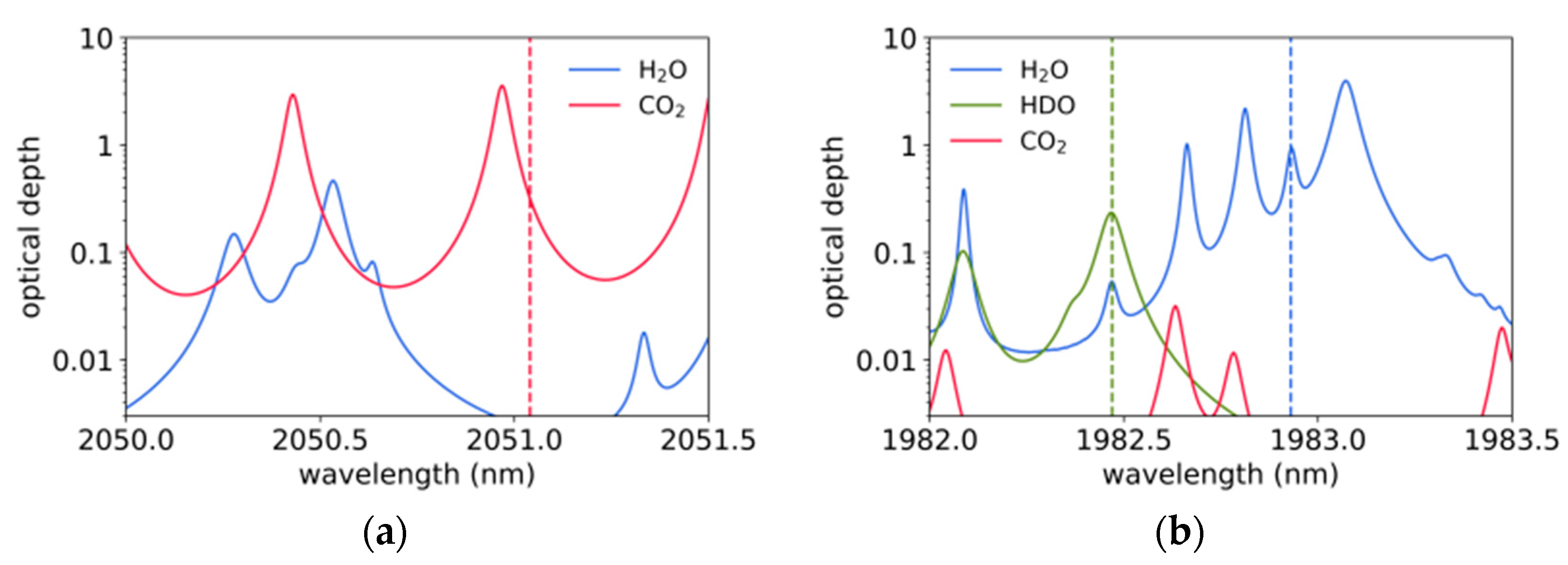
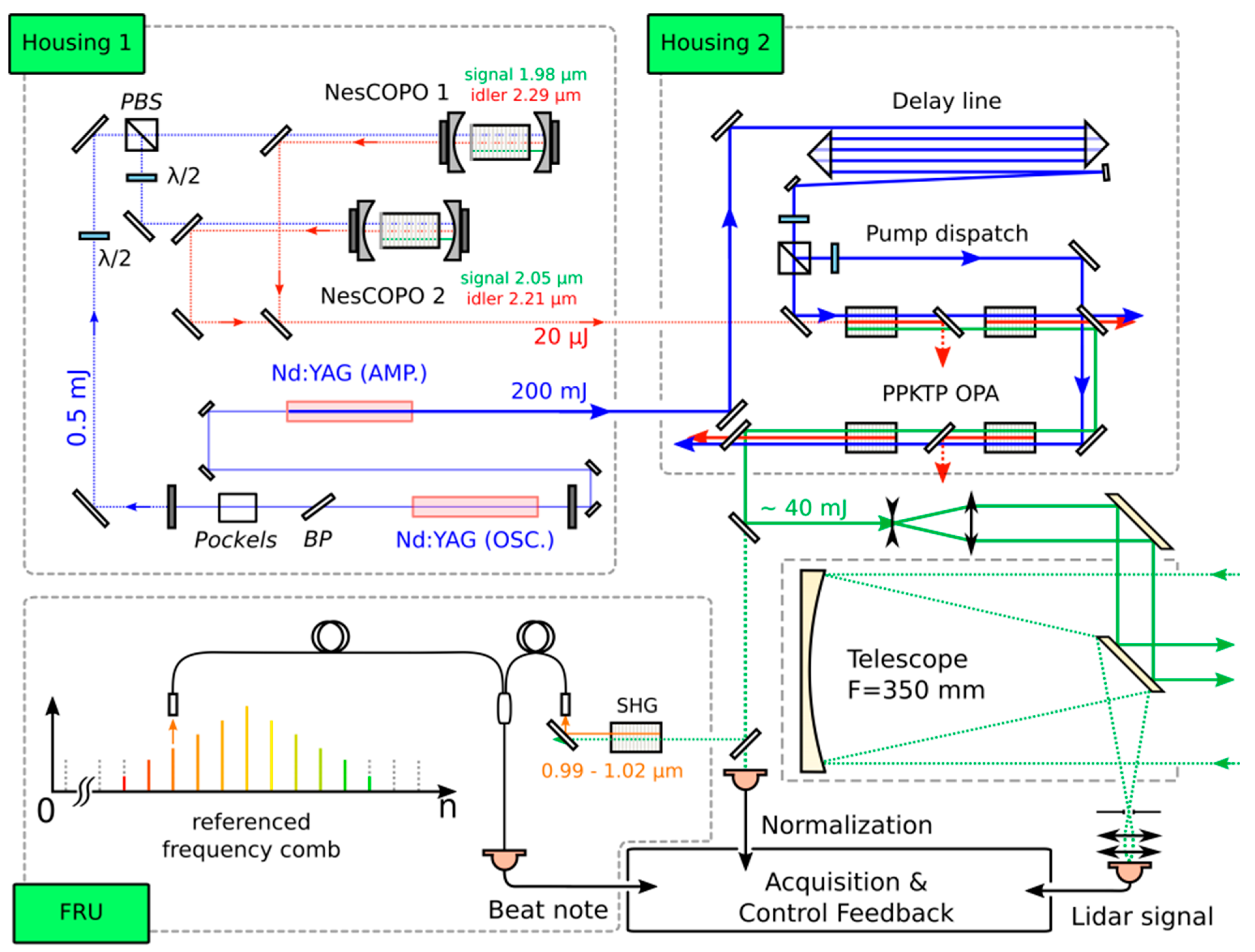
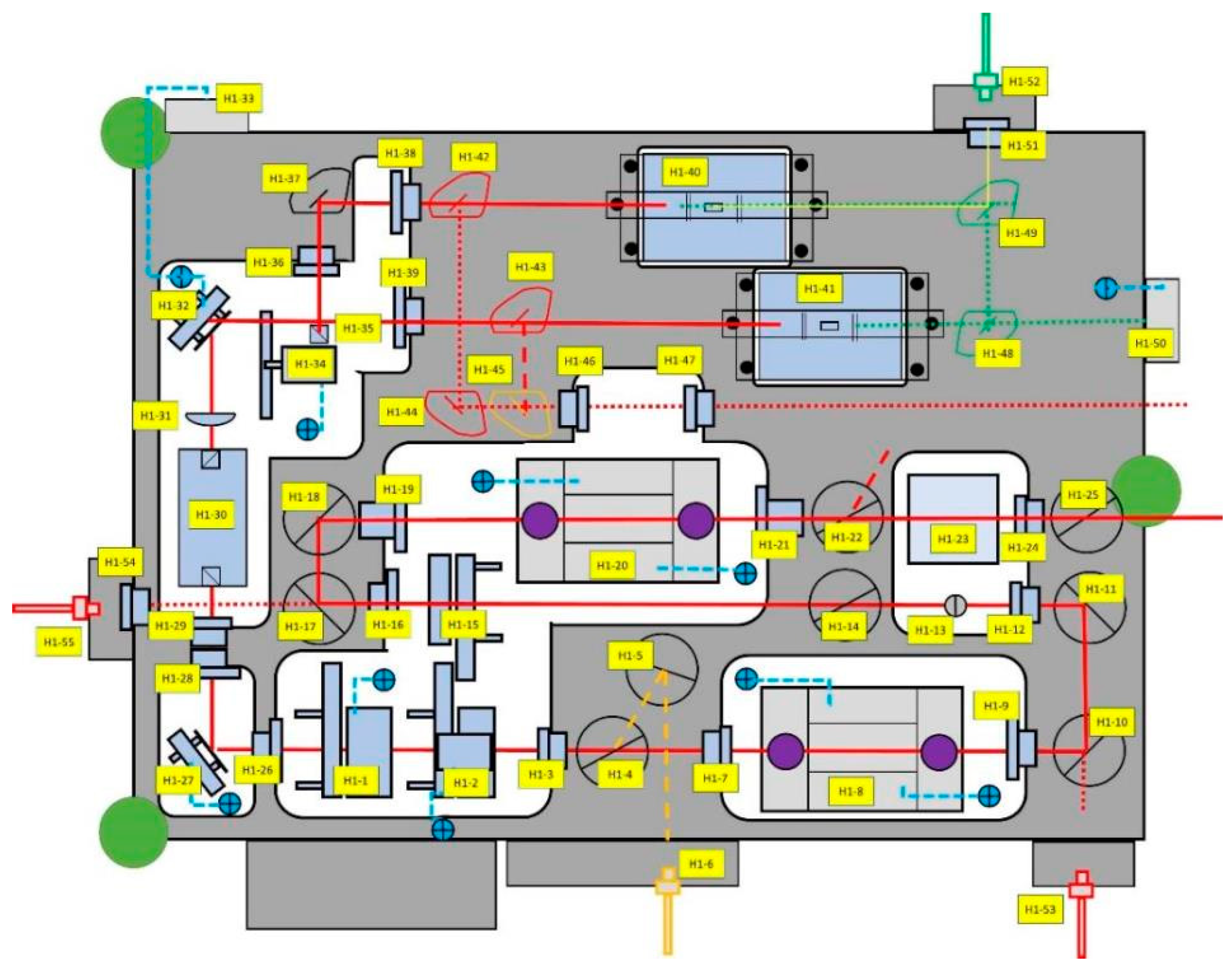

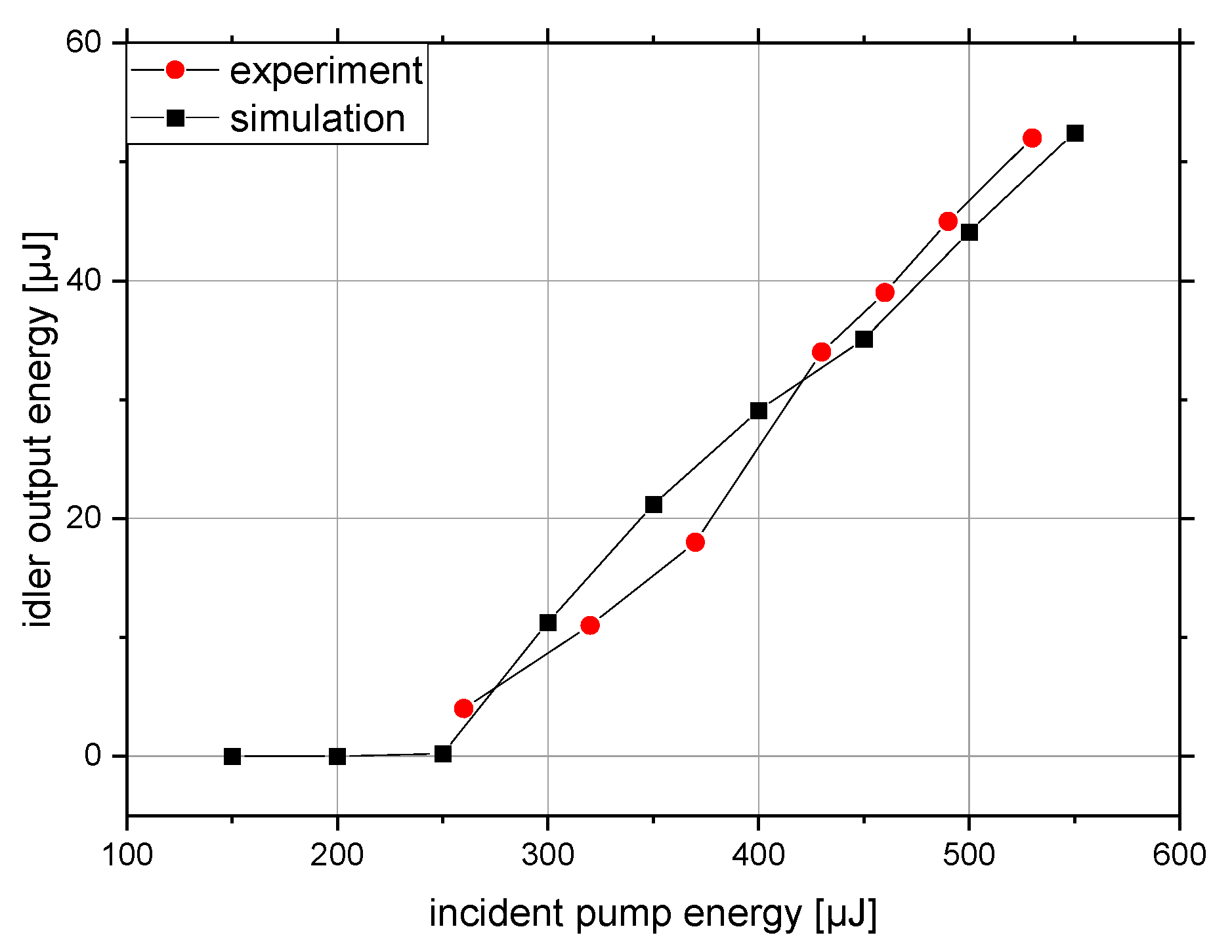

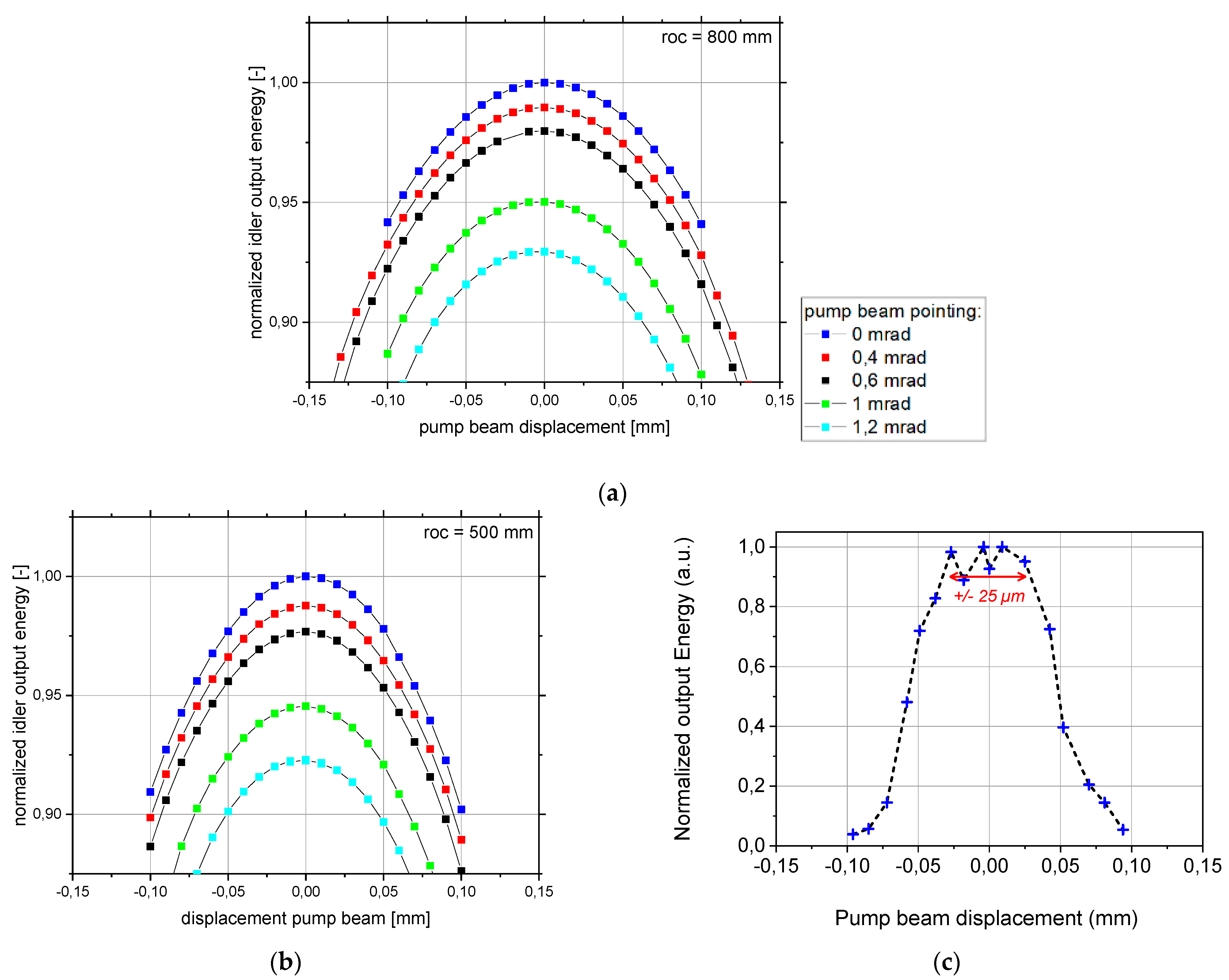
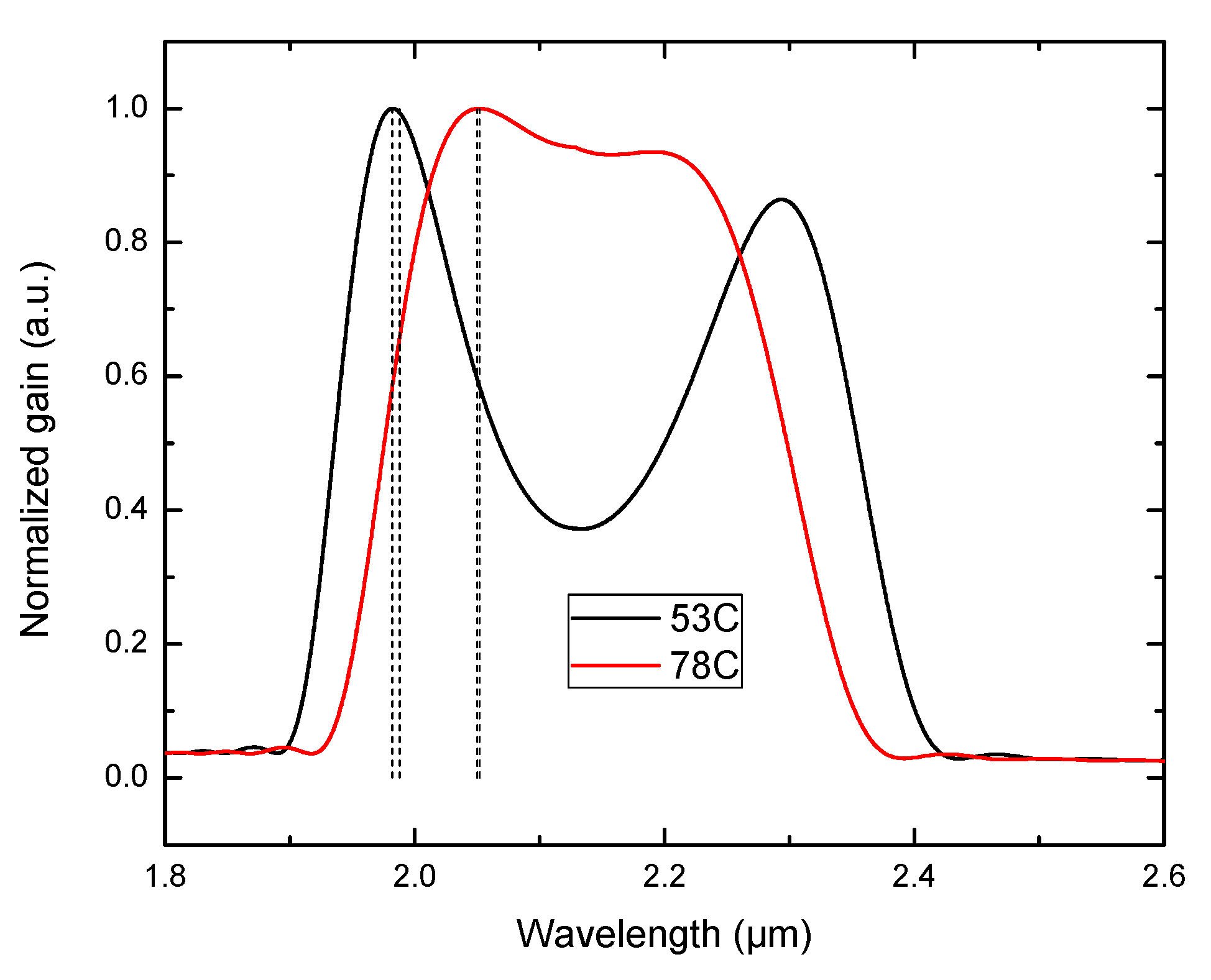

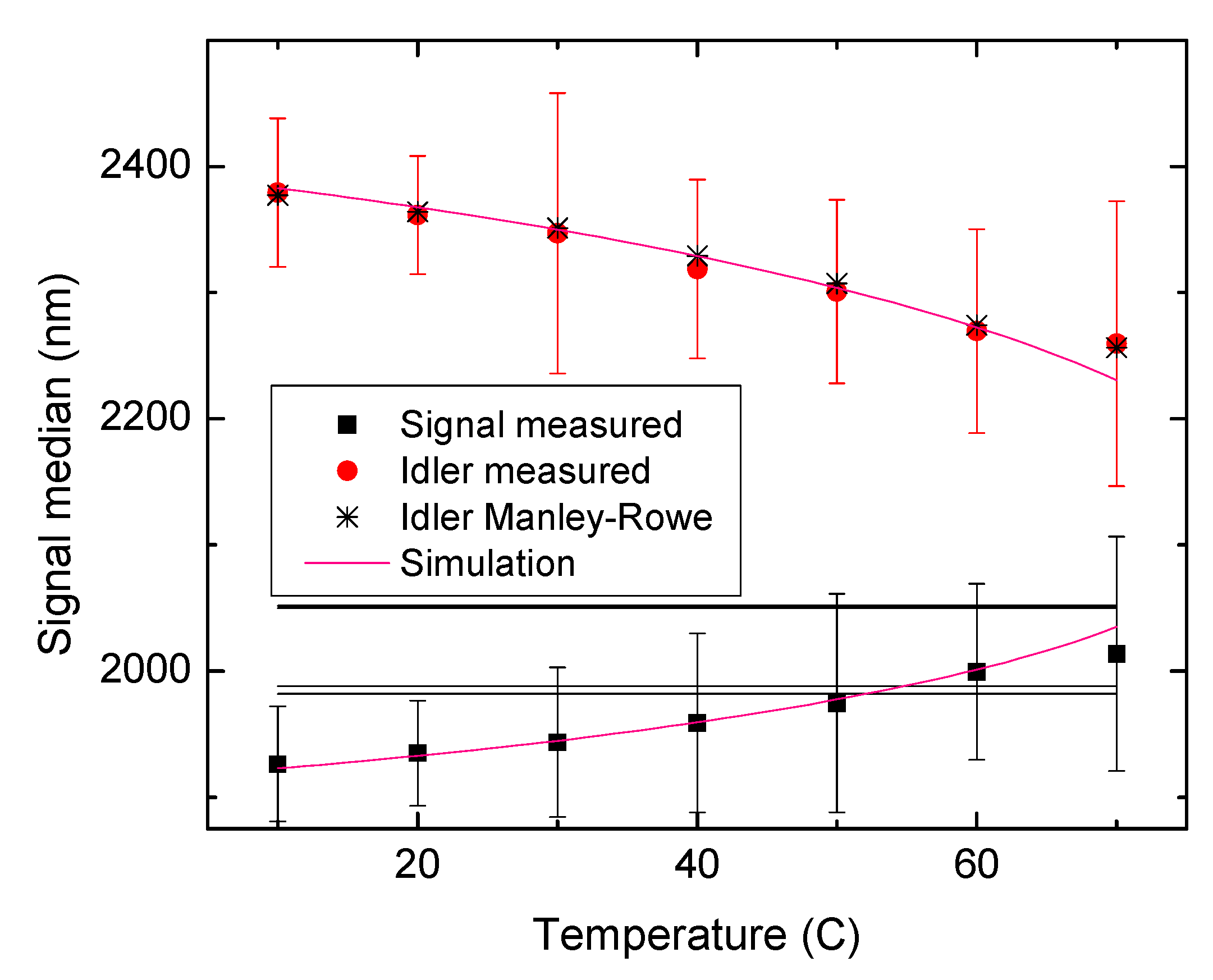
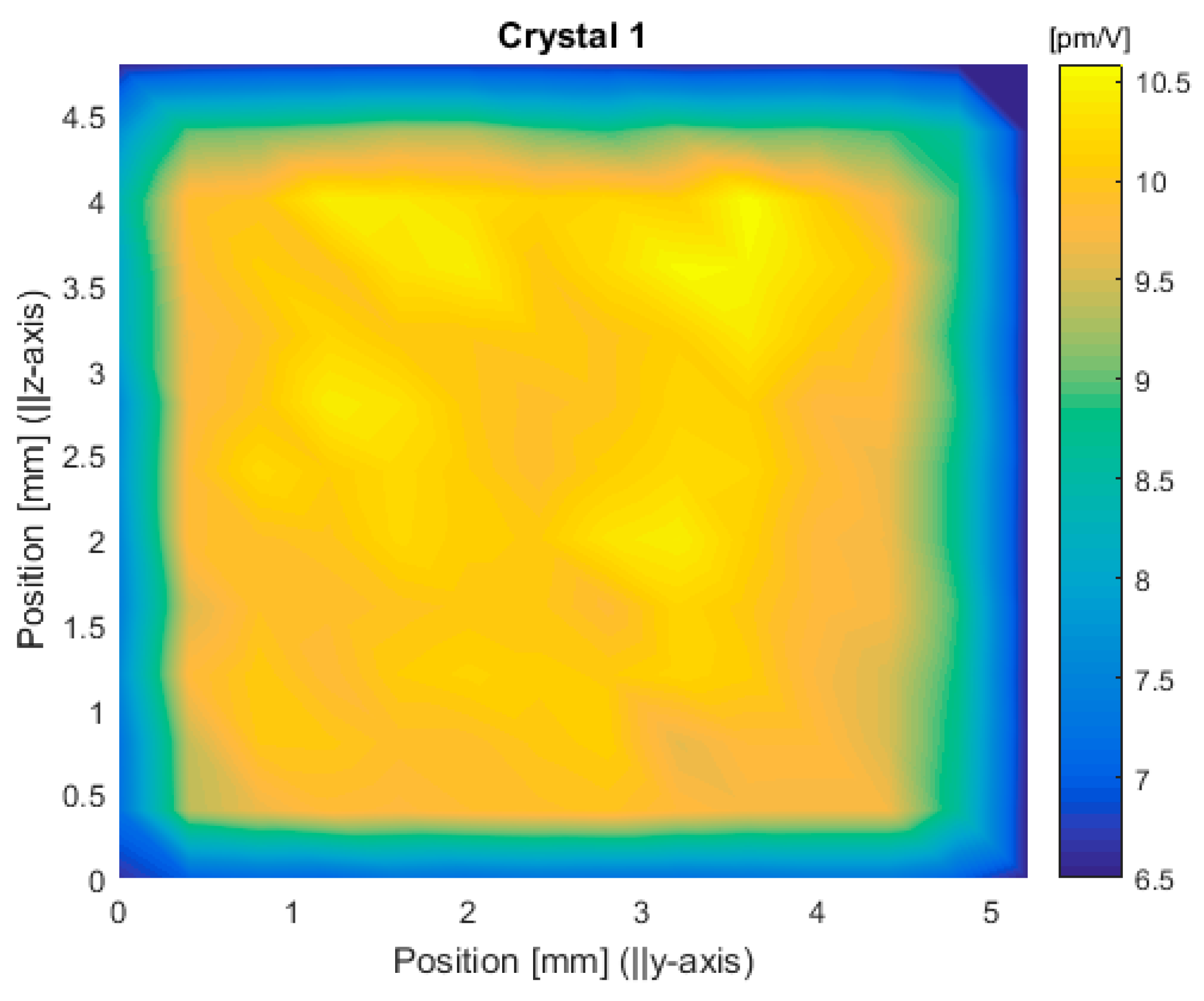
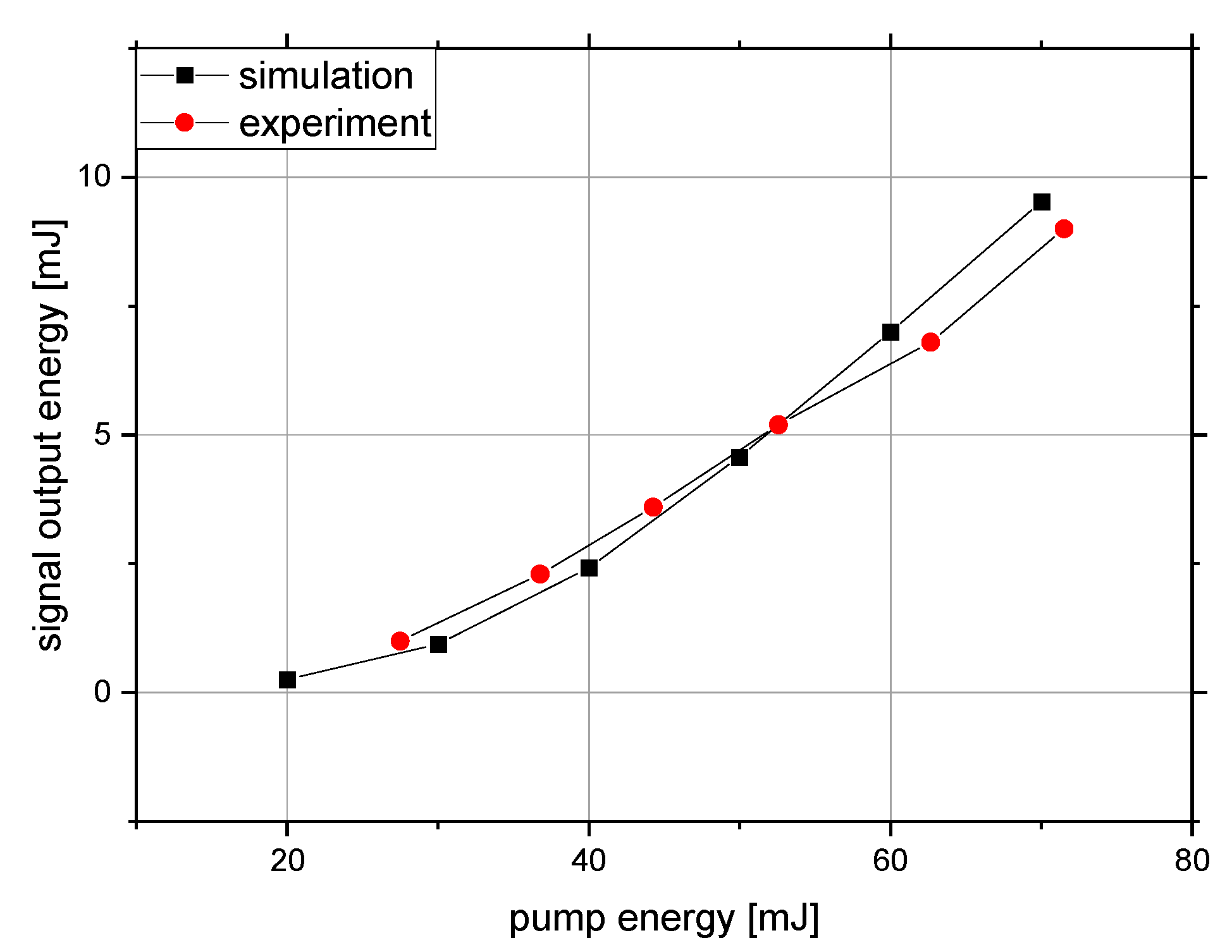
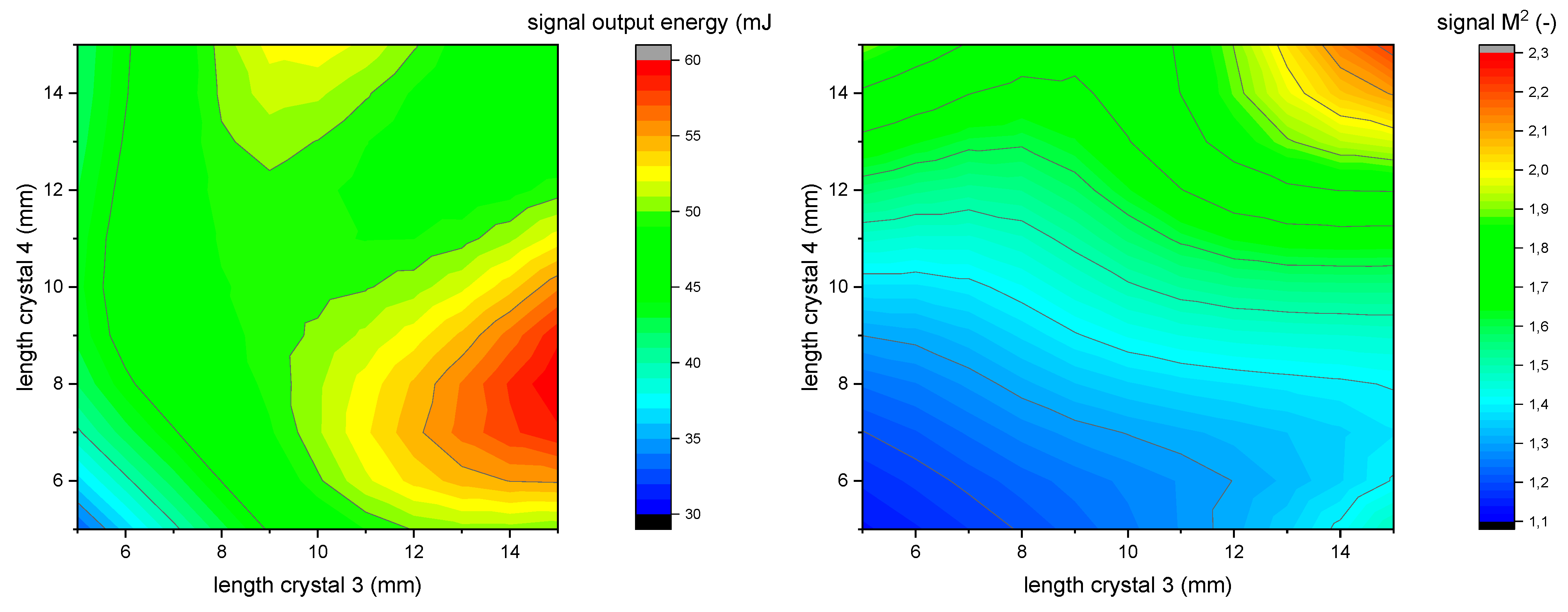
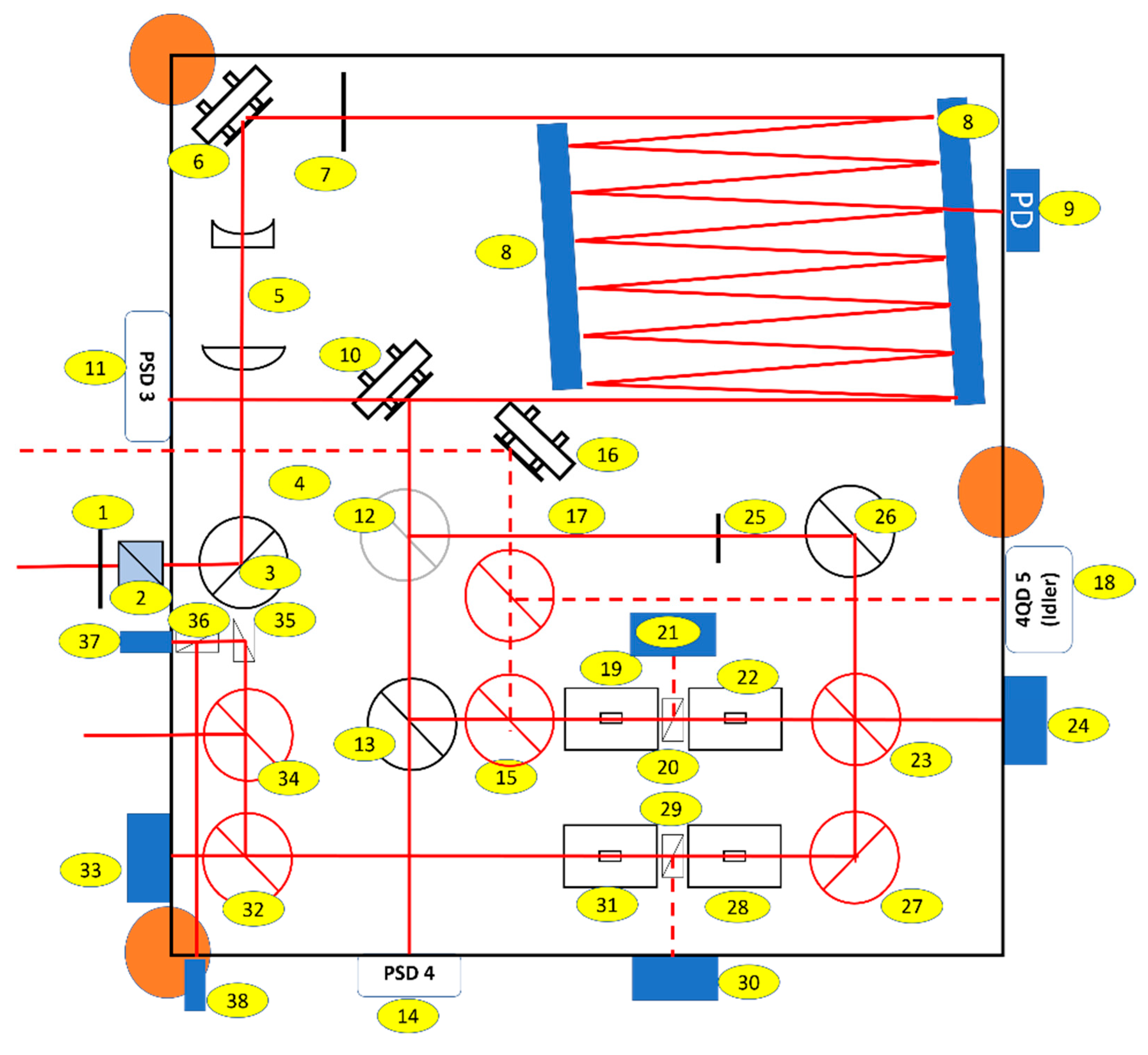
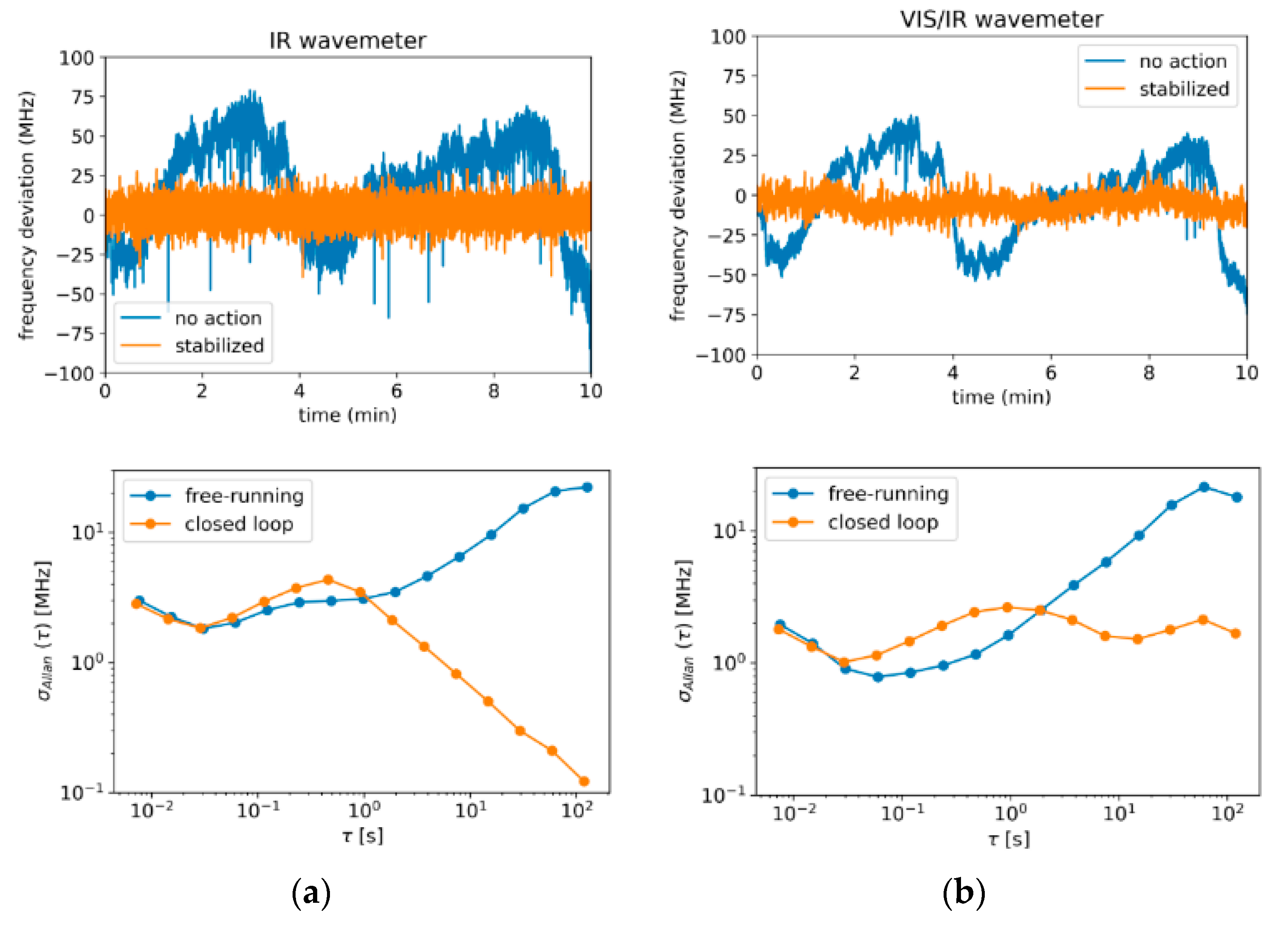
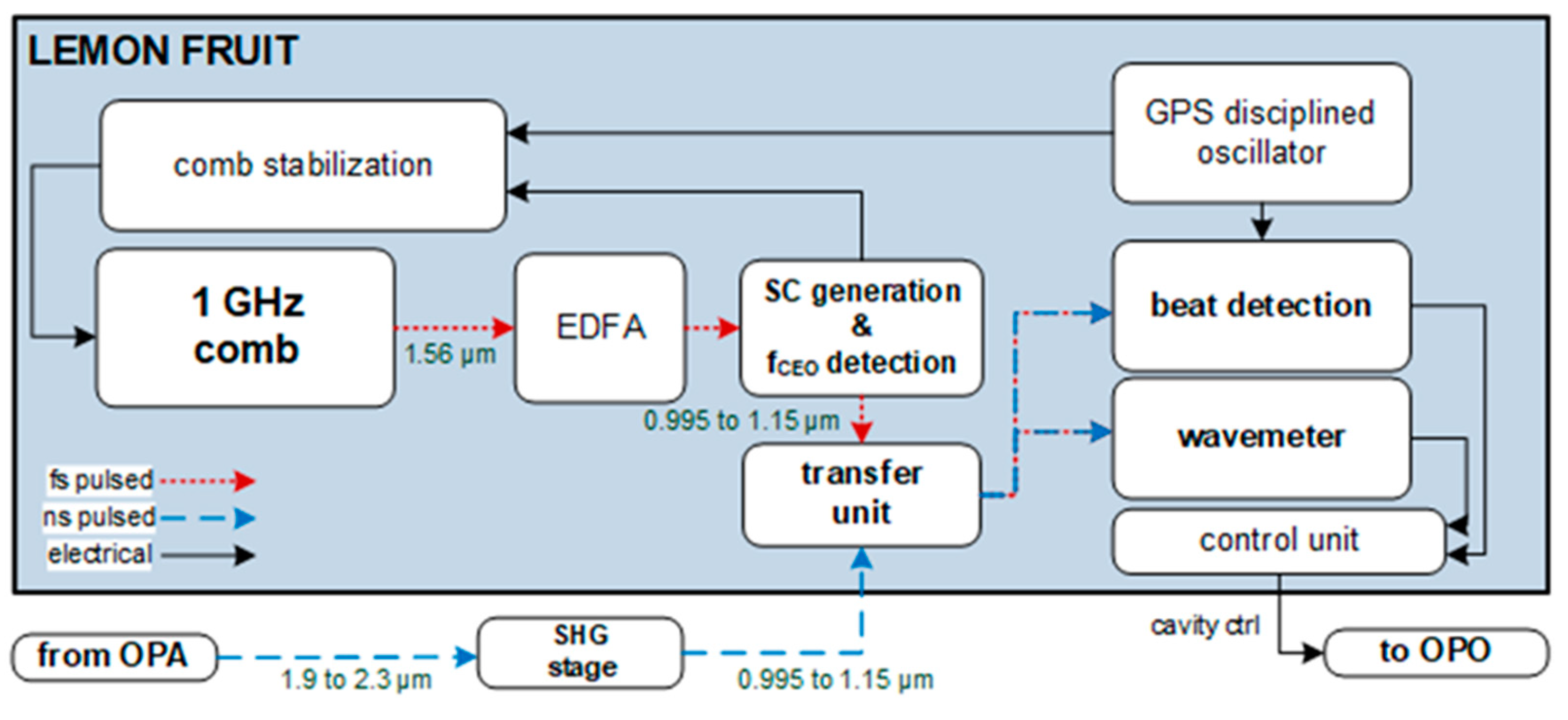
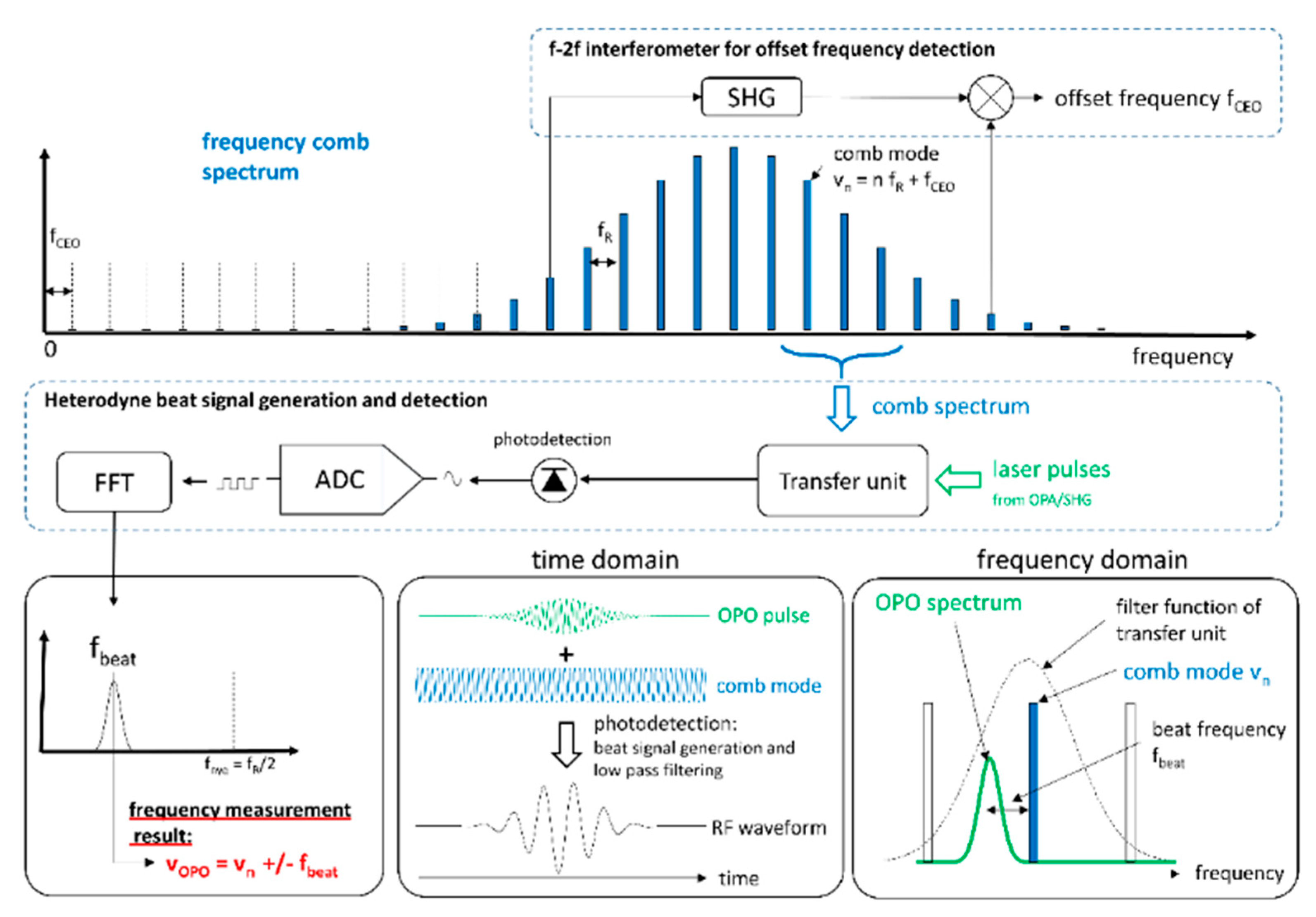
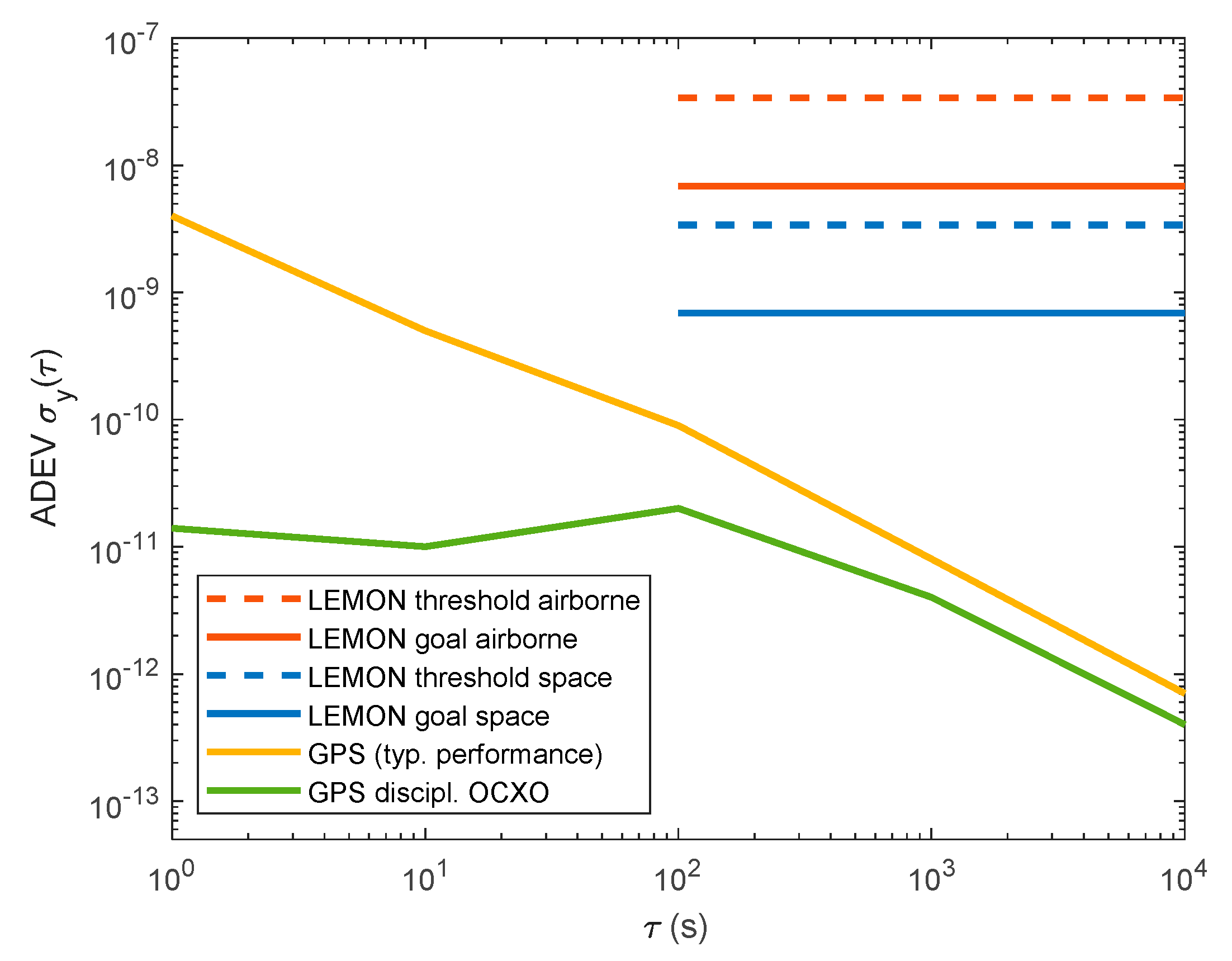
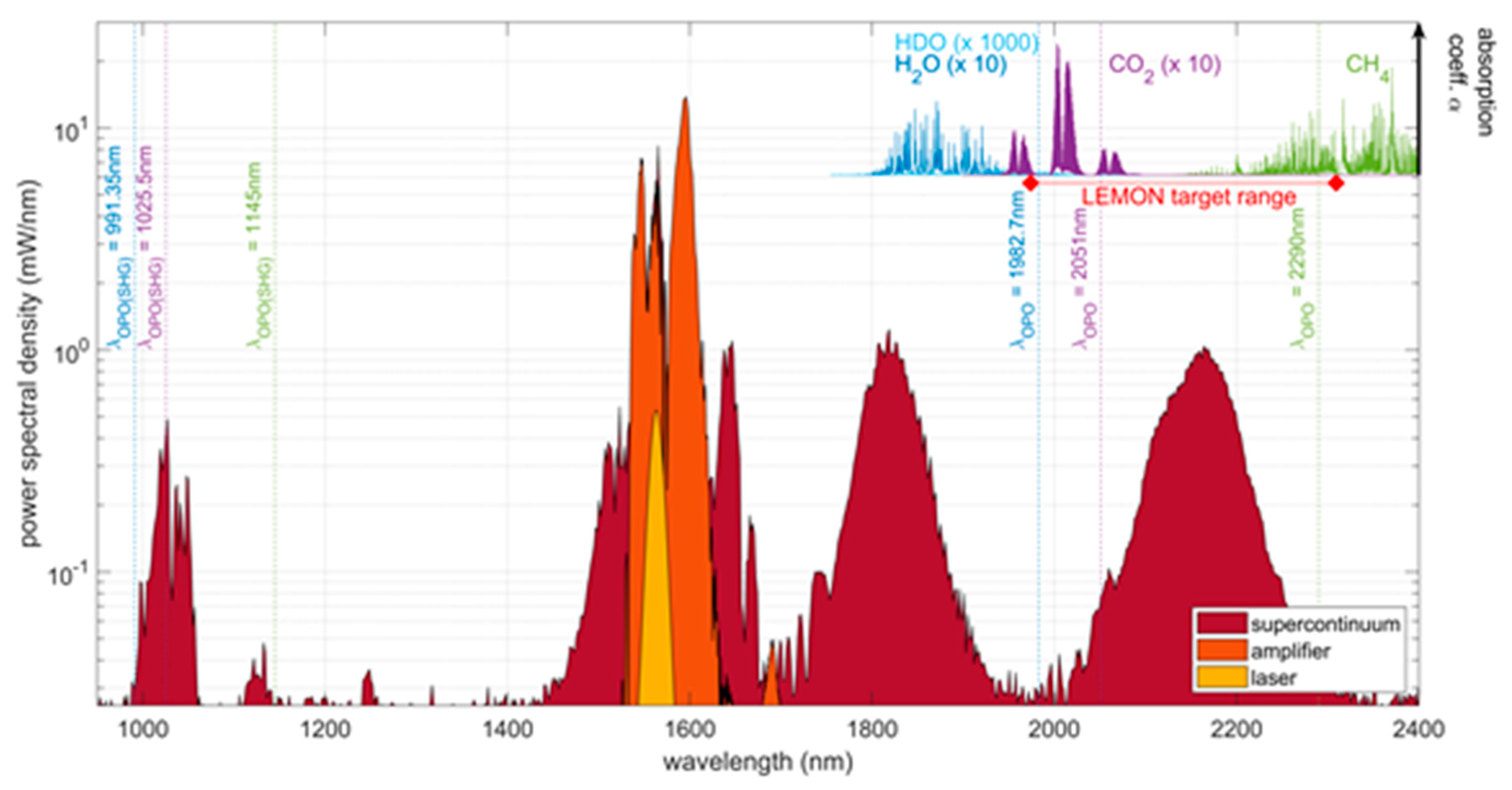
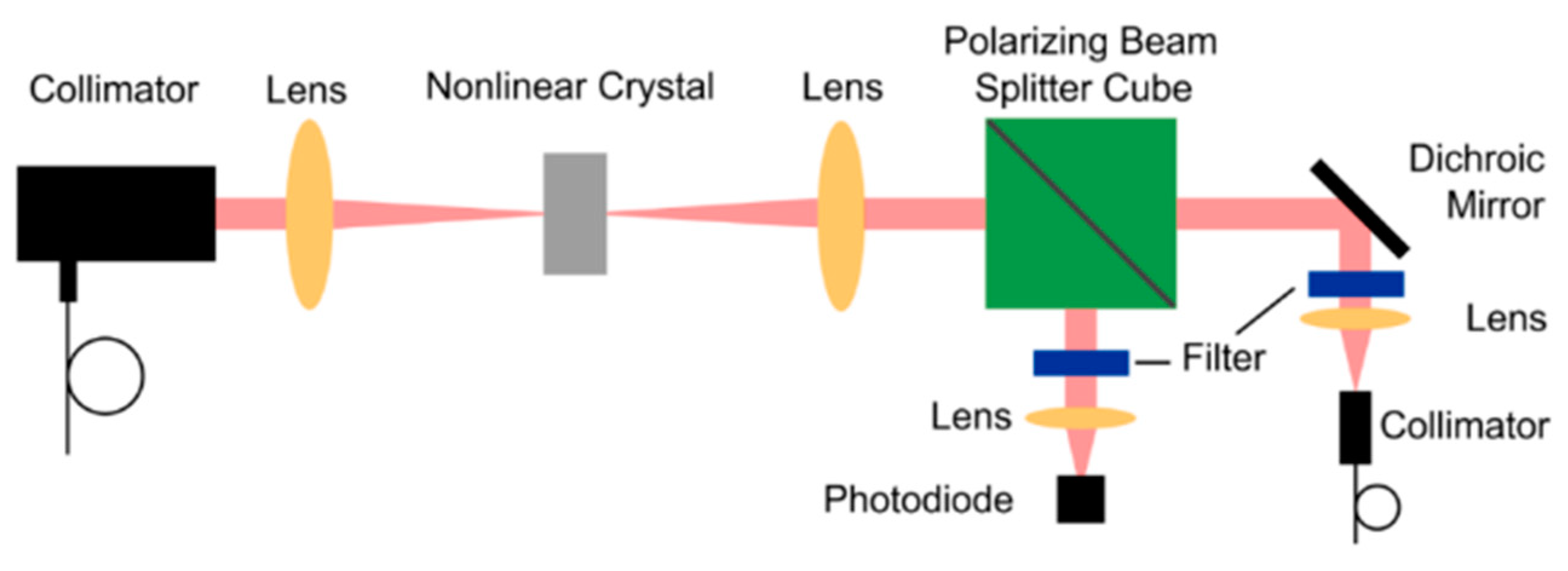
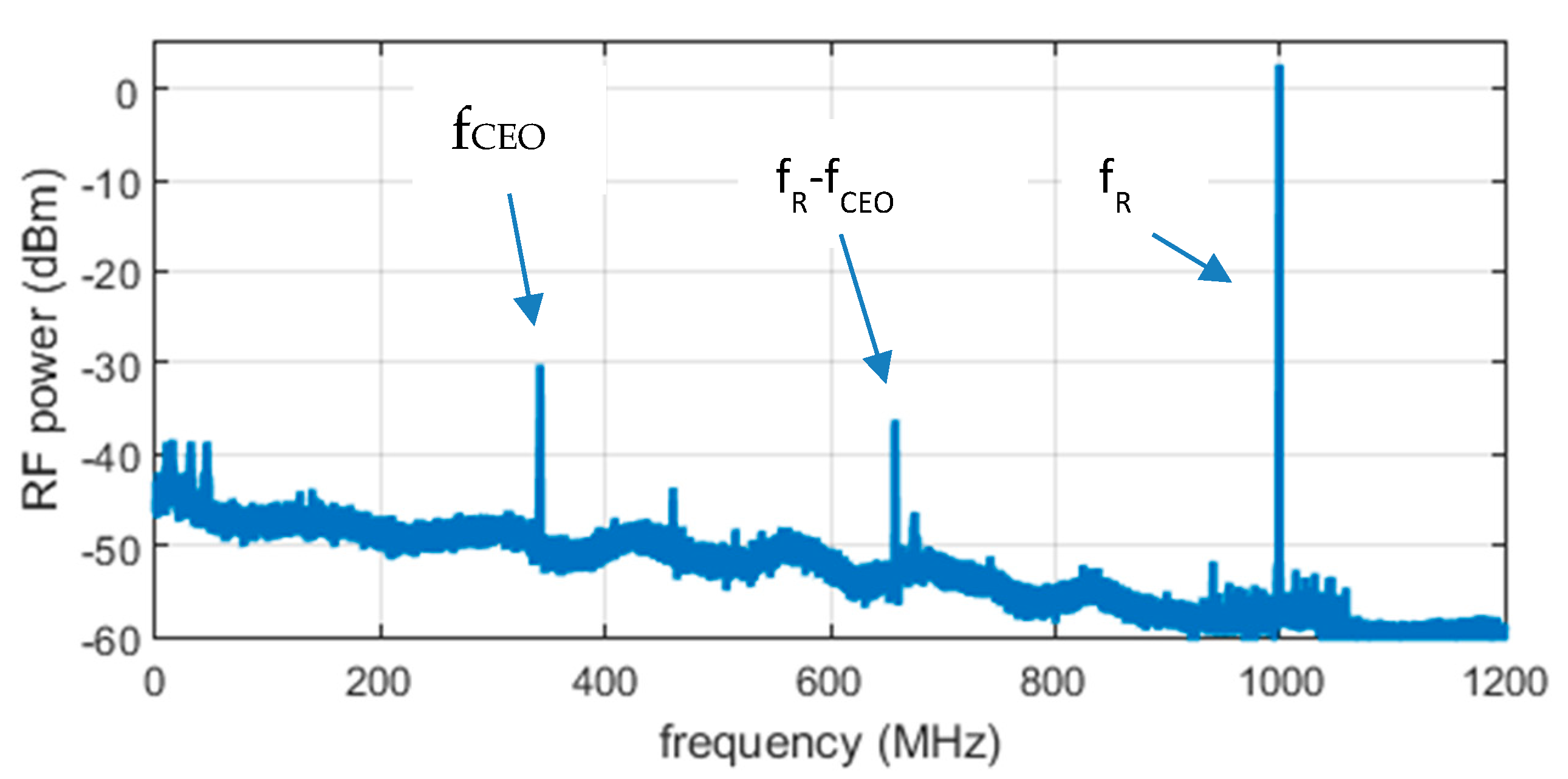

| Parameter | Requirements from Literature and Previous Studies | Objectives for This Study |
|---|---|---|
| ON and OFF frequencies | For CO2 from [4] ON: 4875.59 cm−1 OFF: 4875.386 cm−1 | 3 cm−1 tunability around line center at:
|
| Output energy | Baseline 55 mJ for λON, threshold > 30 mJ [4] | 40 mJ baseline; 30 mJ threshold (taking into account progress in APD technology) |
| λON stability: goal for space | For CO2 from [7]: λON Allan deviation goal better than 0.2 MHz (threshold 1 MHz) RMS over 100 s. Long term drift goal better than 0.1 MHz (threshold 0.5 MHz) |
|
| λON frequency purity: goal for space | 99.93% [4] | Experimental verification |
| Parameter | Value |
|---|---|
| Reflectivity M1 (idler) | 0.8 |
| RoC M1 | 500 mm |
| Reflectivity M2 (signal) | 0.98 |
| Reflectivity M3 (idler) | 0.99 |
| RoC M3 | 500 mm |
| Reflectivity M3 (signal) | 0.99 |
| Reflectivity M3 (pump) | 0.99 |
| Pump beam 1/e2 diameter | 460 μm |
| Distance M1-M2 | 2 mm |
| Distance M3 – Crystal output facet | 0.5 mm |
| Crystal/length | PPLN/10 mm |
| Parameter | Experiment | Simulation |
|---|---|---|
| Reflectivity M1 (idler) | 0.8–0.9 | 0.78 |
| Reflectivity M2 (signal) | 0.98–0.99 | 0.98 |
| Reflectivity M3 (idler) | 0.99 | 0.98 |
| Reflectivity M3 (signal) | 0.99 | 0.96 |
| Reflectivity M3 (pump) | 0.99 | 1 |
| Beam diameter (pump) | 460 μm | 480 μm |
| Parameter | Values |
|---|---|
| Crystal type | PPKTP/PPLN |
| Crystal length in mm | 10/13 |
| Pump beam radius in mm | 0.25/0.35 |
| RoC M1 in mm | 500/800 |
| RoC M3 in mm | 500/800 |
| Parameter | Nominal Value | Simulation Value |
|---|---|---|
| 9.3 (Ref. [54]) | 5.5 = deff/1.69 | |
| Losses at crystal faces | n.a. | 3% |
| Seed energy [µJ] | 10 to 20 | 11 |
Publisher’s Note: MDPI stays neutral with regard to jurisdictional claims in published maps and institutional affiliations. |
© 2021 by the authors. Licensee MDPI, Basel, Switzerland. This article is an open access article distributed under the terms and conditions of the Creative Commons Attribution (CC BY) license (http://creativecommons.org/licenses/by/4.0/).
Share and Cite
Hamperl, J.; Geus, J.F.; Mølster, K.M.; Zukauskas, A.; Dherbecourt, J.-B.; Pasiskevicius, V.; Nagy, L.; Pitz, O.; Fehrenbacher, D.; Schaefer, H.; et al. High Energy Parametric Laser Source and Frequency-Comb-Based Wavelength Reference for CO2 and Water Vapor DIAL in the 2 µm Region: Design and Pre-Development Experimentations. Atmosphere 2021, 12, 402. https://doi.org/10.3390/atmos12030402
Hamperl J, Geus JF, Mølster KM, Zukauskas A, Dherbecourt J-B, Pasiskevicius V, Nagy L, Pitz O, Fehrenbacher D, Schaefer H, et al. High Energy Parametric Laser Source and Frequency-Comb-Based Wavelength Reference for CO2 and Water Vapor DIAL in the 2 µm Region: Design and Pre-Development Experimentations. Atmosphere. 2021; 12(3):402. https://doi.org/10.3390/atmos12030402
Chicago/Turabian StyleHamperl, Jonas, Jan Fabian Geus, Kjell M. Mølster, Andrius Zukauskas, Jean-Baptiste Dherbecourt, Valdas Pasiskevicius, Lukas Nagy, Oliver Pitz, David Fehrenbacher, Hanjo Schaefer, and et al. 2021. "High Energy Parametric Laser Source and Frequency-Comb-Based Wavelength Reference for CO2 and Water Vapor DIAL in the 2 µm Region: Design and Pre-Development Experimentations" Atmosphere 12, no. 3: 402. https://doi.org/10.3390/atmos12030402
APA StyleHamperl, J., Geus, J. F., Mølster, K. M., Zukauskas, A., Dherbecourt, J.-B., Pasiskevicius, V., Nagy, L., Pitz, O., Fehrenbacher, D., Schaefer, H., Heinecke, D., Strotkamp, M., Rapp, S., Denk, P., Graf, N., Dalin, M., Lebat, V., Santagata, R., Melkonian, J.-M., ... Flamant, C. (2021). High Energy Parametric Laser Source and Frequency-Comb-Based Wavelength Reference for CO2 and Water Vapor DIAL in the 2 µm Region: Design and Pre-Development Experimentations. Atmosphere, 12(3), 402. https://doi.org/10.3390/atmos12030402






